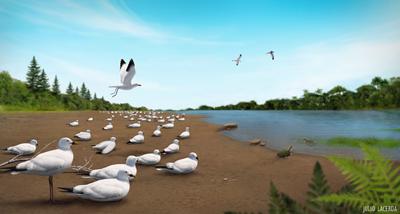Colonial breeding in Mesozoic birds
Palaeontologists at the University of Southampton’s National Oceanography Centre Southampton, have discovered important new evidence that suggests for the first time that Mesozoic birds from the Cretaceous period congregated into large colonial groups in order to breed.
Researchers including Gareth Dyke and Darren Naish of the University of Southampton, Gary Kaiser of the Royal British Columbia Museum and Mátyás Vremir of the Translyvanian Museum Society, have found fossil evidence for a breeding colony of Mesozoic birds, preserved at the Cretaceous Sebes formation of Transylvania in western Romania.
Despite a rapidly improving fossil record, very little is known about the reproductive biology of Mesozoic birds: only a handful of undisputed, isolated Cretaceous eggs have been found worldwide, so many questions around the nesting habits of these ancient relatives of modern birds still remain.
As Mesozoic birds were very diverse in terms of size and shape, and with the limited evidence that has exited to date, it was widely presumed that their breeding behavior would be similarly varied. However, the team located a lens of mudstone which contained thousands of tightly packed, structurally identical eggshell fragments, as well as
several near-complete eggs and neonatal and adult skeletal elements from avialans. The eggshell remains and bones exhibit clear characteristics of the Cretaceous group of primitive birds enantiornithines. The volume of the remains that were found, and the fact they belonged to the same single species, clearly suggests colonial nesting behaviour, which has not been considered before for enantiornithines.
The team conclude that due to the formation of the remains, and the geological characteristics of the rock in which they were preserved, the colony’s demise could have been the result of a flood in the area, a fate which regularly befalls modern waterside nesting colonies. It appears this colony drowned in rising water, was washed a short distance and then deposited where they became fossilised. Such a large concentration of breeding birds in this area suggests that the enantiornithes species may have had aquatic feeding tendencies, expanding our knowledge of enantiornithine biology.
Researcher Gareth Dyke comments: “Through findings like this we are able to expand our understanding of the workings of modern day creatures. It’s a novel idea that this particular group of enantiornithines would form large waterside nesting colonies, or be particularly dependent on aquatic resources to survive – but this new finding has shed significant light on the nesting habits of this species.”
The findings have been published in Naturwissenschaften: The Science of Nature.

Links to external websites
The University cannot accept responsibility for external websites.